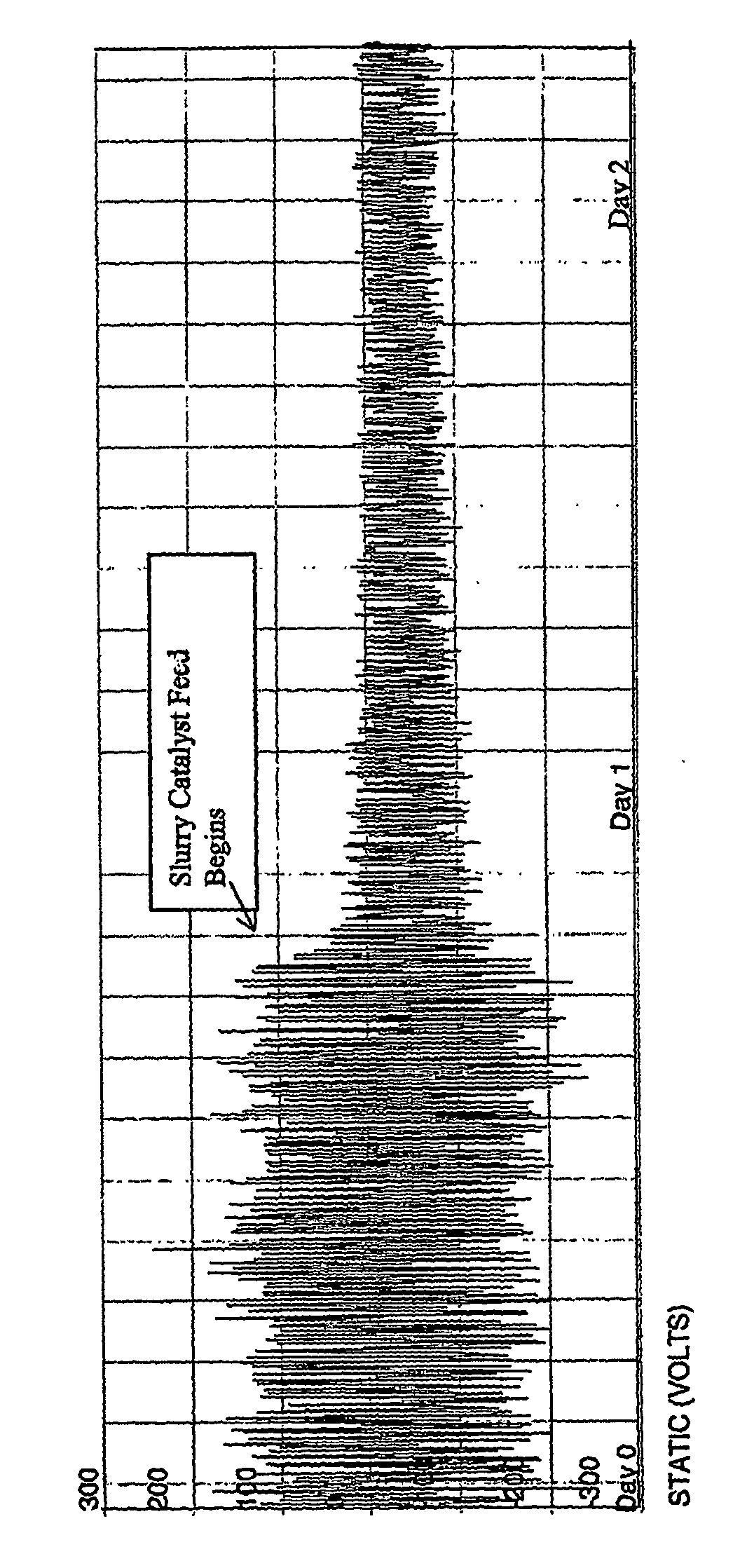Chromium-based catalysts in mineral oil for production of polyethylene
a technology of chromium-based catalysts and mineral oil, which is applied in the field of chromium-based catalysts for the production of polyethylene, can solve the problems of complex design and maintenance of solid catalyst feeders, inability to pursue slurry catalyst feed, and inability to achieve gas phase polymerization, etc., to achieve the effect of reducing static, preventing charge generation, and reducing static in operation
- Summary
- Abstract
- Description
- Claims
- Application Information
AI Technical Summary
Benefits of technology
Problems solved by technology
Method used
Image
Examples
examples
Catalyst 1a and 1b
[0035] Chromium oxide based catalysts are made as described in EP 0640625 A2. Catalyst 1a is available as UCAT™ B-300 and Catalyst 1b is available as UCAT™ Catalyst B-375 from Univation Technologies LLC. These catalysts differ in the amount of chromium present on the silica support and hence the final amount of Cr+6 present in the finished catalyst. As described in EP 0640625 A2, such catalysts may be prepared by the following multi-step procedure:
[0036] Step 1: (Drying)—A chromium acetate containing silica (0.2 wt percent Cr for Catalyst 1a and 0.5 wt. percent Cr for Catalyst 1b, having 70 percent of its pore volume in pore size greater than 100 Angstroms (Davison® 957 brand silica, available from Grace-Davison Corporation) is introduced into a fluid-bed drying vessel maintained under nitrogen at ambient temperature and pressure. The temperature of the vessel is increased to 150° C. at a rate of 50° C. / hour. The silica is held at 150° C. for 4 hours and then co...
examples 1-12
[0046] Catalyst activities are tested in lab scale autoclave polymerization reactors in the absence and in the presence of diethyl zinc scavenger (mole ratio Zn:Cr=1:1) and in the presence of triethyl aluminum (TEA) (50 μl of a 1 mole percent TEA hexane solution for Examples 1 and 2, 25 μl for Examples 3-6). Results (shown in Table 1) indicate that all catalyst slurries have acceptable activities.
TABLE 1Activity Results for Catalyst SlurriesExample123456Catalyst Slurry1a1a22mixedmixedDiethyl Zincnoyesnoyesnoyes1 percent TEA505025252525solution, μlActivity, g PE / g8561414450788300550catalystStandard activity,2674—450—n / an / ag PE / g catalyst
[0047] SEC analysis of the resulting polymer samples indicate that in the mixed catalyst experiment (Examples 5 and 6), both chromium-based catalysts produce polymer.
Offline Feeding Tests
[0048] The previously disclosed slurries of Catalyst 1a, Catalyst 2, and the 30 / 70 mixture are fed from a syringe pump slurry feeder to a stainless steel beaker ...
example 13
[0051] A gas phase polymerization reactor is operated at steady state conditions feeding dry catalyst 1b at the reactor conditions disclosed for Comparative B. After approximately 18 hours operation, dry catalyst feed is discontinued and slurry catalyst 1b feed begins. All other reactor conditions are held constant. Upon commencement of slurry catalyst feed, and at the same average polymer production rate, static voltage measured in the reactor decreases for the duration of the test. This result is illustrated graphically in FIG. 1, which shows the decrease in static voltage measured at a level approximately 2 feet above the gas distribution plate upon replacement of dry catalyst feed with slurry catalyst feed.
PUM
| Property | Measurement | Unit |
|---|---|---|
| Temperature | aaaaa | aaaaa |
| Dynamic viscosity | aaaaa | aaaaa |
Abstract
Description
Claims
Application Information
 Login to View More
Login to View More - R&D
- Intellectual Property
- Life Sciences
- Materials
- Tech Scout
- Unparalleled Data Quality
- Higher Quality Content
- 60% Fewer Hallucinations
Browse by: Latest US Patents, China's latest patents, Technical Efficacy Thesaurus, Application Domain, Technology Topic, Popular Technical Reports.
© 2025 PatSnap. All rights reserved.Legal|Privacy policy|Modern Slavery Act Transparency Statement|Sitemap|About US| Contact US: help@patsnap.com



